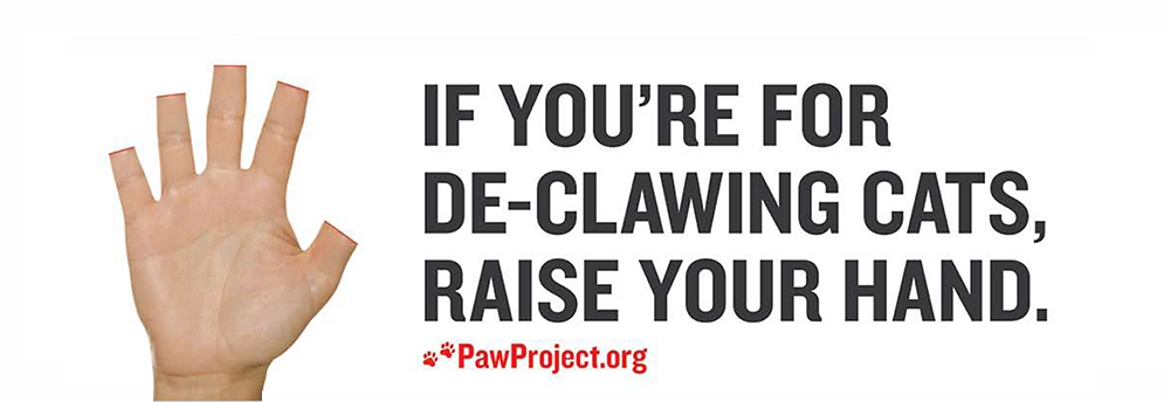... since 1995
DECLAWING IS AN AMPUTATION !!
You should know that this surgery, which is often called onyxectomy, is in fact a phalangectomy.
As the name suggests, it is an amputation of the third joint of each finger of the cat and it is a major surgery.
Even if we cannot compare two different animal species in their physiognomy, we could say that it is the equivalent of having the tips of our fingers amputated, at the joint located above the nails.
And regardless of the surgical instrument used (Resco, scalpel or laser), the result and the consequences are the same.
A PRACTICE THAT MUST BE PROHIBITED!
AT SHINKARA CATTERY, WE ARE AGAINST DECLAWING.
Since 2017, it is now prohibited for Quebec veterinarians to perform, other than for medical reasons, ear trimming in dogs (spinning) and tail trimming (tail docking) in dogs, cats, cattle and horses. Like the majority of Canadian provinces, the province of Quebec thus joins many countries in Europe, as well as Australia and New Zealand, which have prohibited these interventions for several years.
The ban on feline declawing should follow shortly.
ALTERNATIVES THAT WORK:
THE 3-5 METHOD
Here is a technique that will ensure that in less than 5 days (average), the vast majority of cats will use a scratching post if you put these 3 points in place.
Point 1. A stable scratching post: The post must be as stable as the tree it is supposed to replace. Unfortunately, the majority of those offered in stores fall as soon as a cat puts a paw on them. If your scratching post has already been purchased, but is inadequate, lift the corner of the sofa and stabilize it by sliding its base under the leg of the furniture. Thus, your post will not only be stable, but also positioned in the right place, on the corner of the couch. The scratching post must be high enough for the cat to lie down full length to stretch its spine. 91 cm (36”) is a good height for an average sized cat. Note that many cats also like to have additional horizontal support such as a rug or a log of wood. Stability is always key.
Point 2. Position the scratching post in the right place The cat scratches, among other things, to mark its territory. It's a bit like planting a sign "private land" in its territory. Just like us, the cat wants to plant these signs in a place visible to all, at the entrance to said territory. Since the corner of the sofa is often placed in this place, it is often the target of a cat's scratching. But whether it's the door frame or any other location, you just have to put the scratching post where the cat wants to scratch and not where we would like him to scratch.
Point 3. Make the scratching post attractive: Make him discover the joys of planting his claws on this scratching post by playing with a toy stick on it or by putting some catnip on it. Each feline has its preferences: carpet, rope, cardboard and wood are all excellent materials.
THE 3-10 METHOD
If a cat has already damaged a wooden structure or a fabric on the sofa, the mere sight of the vertical ridges made by its claws will lead it to continue scratching there even if you have installed a good scratching post. It is better to repair the surface and make these streaks disappear.
Here is a 3-step method that will ensure that the majority of cats will be using their scratching post rather than your sofa in less than 10 days.
STEP 1 - We must make the place currently used unpleasant by installing a plastic sheet, aluminum foil or double-sided tape directly on the affected place or on the ground where the cat settles to do his claws. These textures are rarely appreciated by felines.
STEP 2 - It is very important to give the cat an alternative. Place a scratching post on the corner of the couch. The surface of it made unpleasant in step 1, he will have no choice but to use it. Refer to method 3-5 to make sure you have a good scratching post placed in the right place.
STEP 3 - Play with him using a toy stick that you will land on the scratching post to encourage him to sink his claws there. You can also put some catnip on it to make it nice. Once he gets used to scratching it, you can remove the plastic sheet or aluminum foil.
NAIL CAPS
If you are still not convinced of the effectiveness of the proposed alternatives, you can use the Soft Paws while you see if the scratching post works. This alternative makes it possible to cover each claw with a small plastic envelope. Although you can put them on your cat yourself, be aware that many veterinarians offer to do so at little cost to you.
- Extracts from the EDUCHATEUR.COM website

